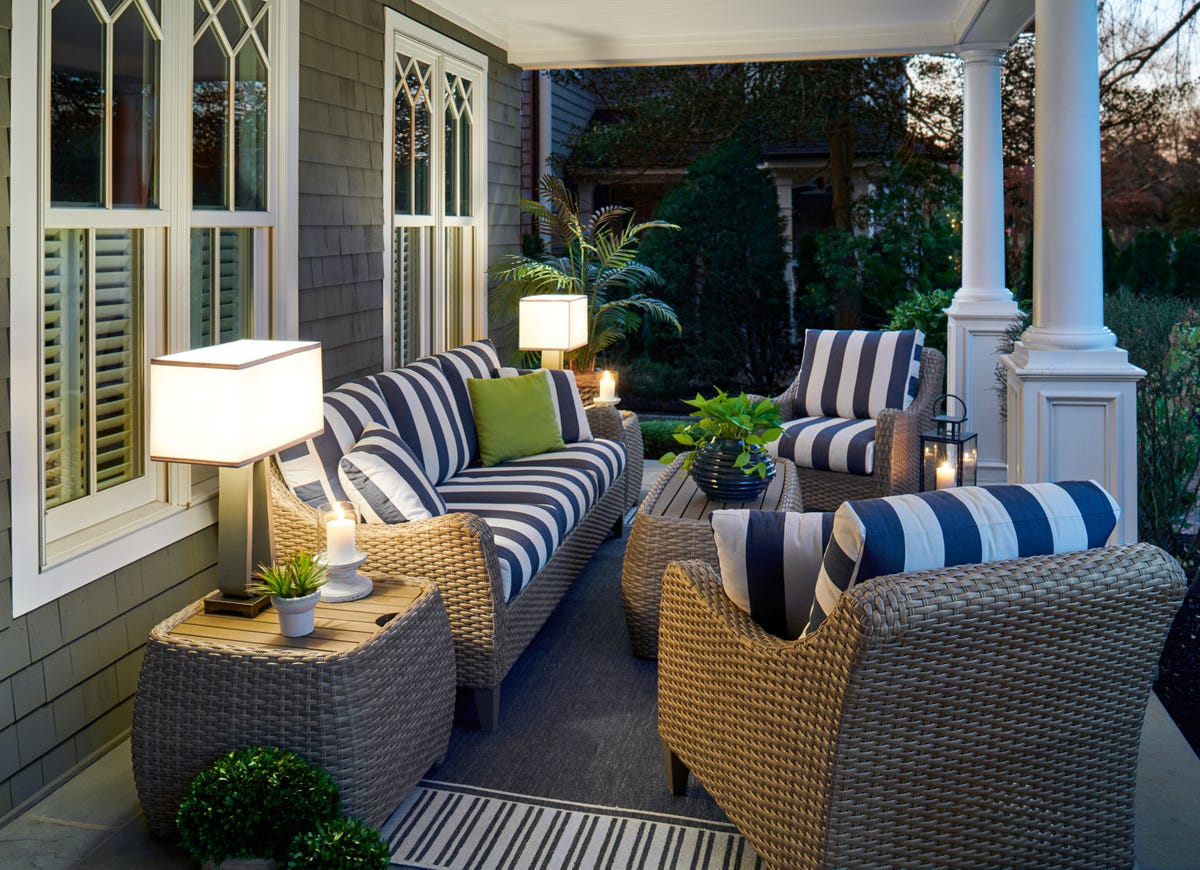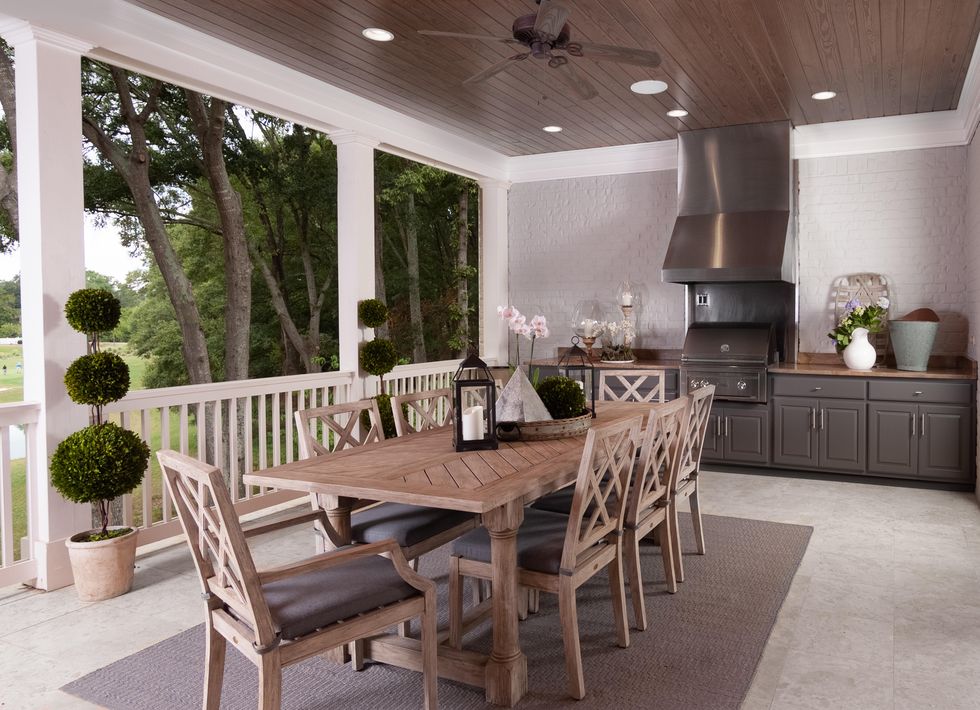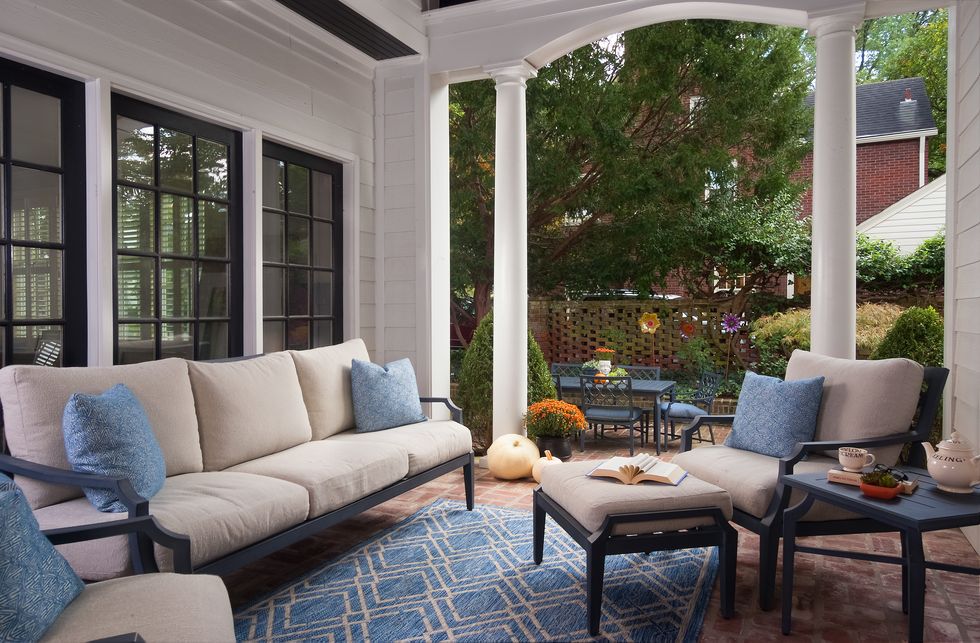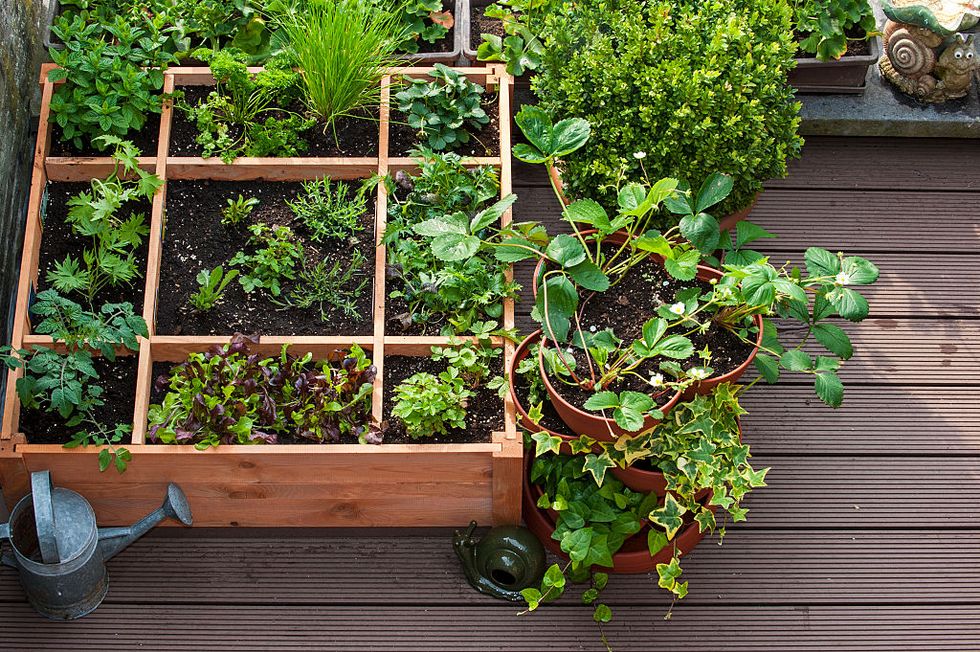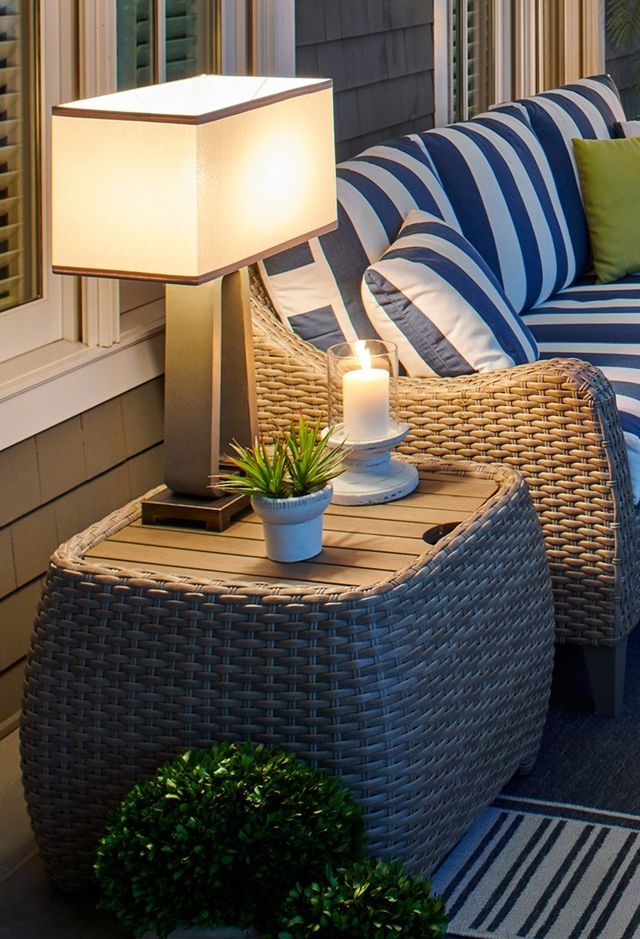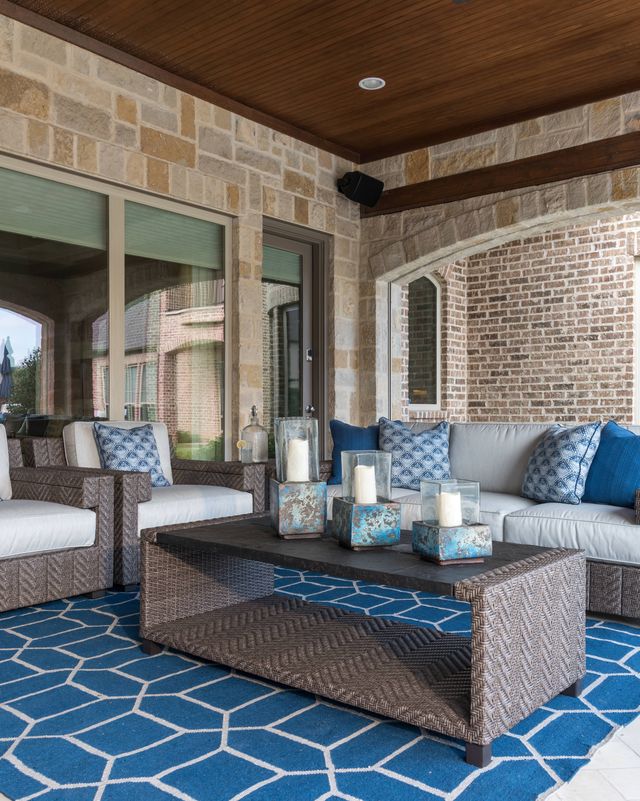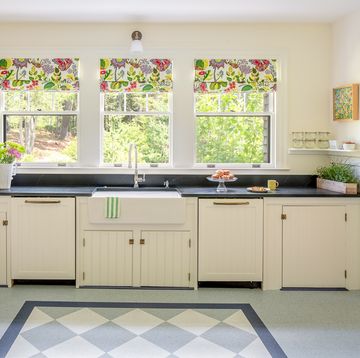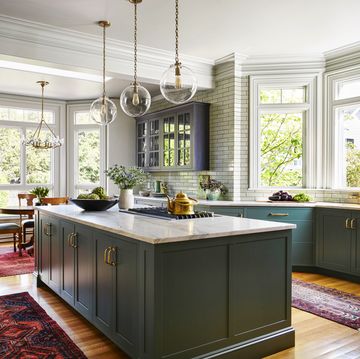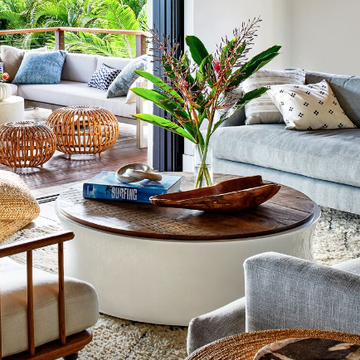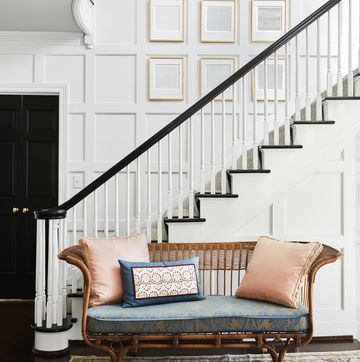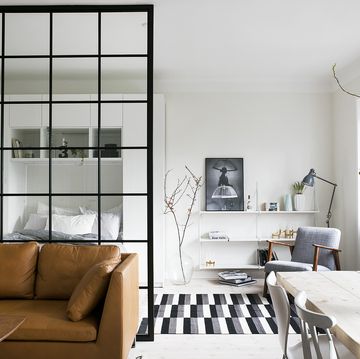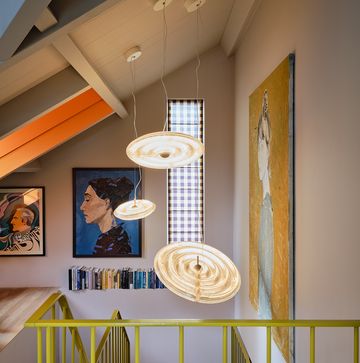For even the savviest of home decorators, creating a well-appointed outdoor space can pose a challenge. It’s often an undefined space with no walls or hard boundaries, and the design has to contend with the elements (not to mention birds and bugs). It’s a lot to consider.
But the key to designing a successful outdoor space, according to interior designer Diana Apgar of Decorating Den Interiors, a network of individually owned and operated interior design franchises throughout the U.S. and Canada, is actually quite simple: Approach it the same way you would any room in the house.
That means consider your wants and needs for the space, sketch out a floor plan, and choose a color palette and style that complements the adjacent spaces. In this case, that would be the exterior of a home and surrounding landscape.
But one person’s dream backyard may be another’s high-maintenance nightmare. To ensure that yours is truly an oasis for you, the most important factor to consider is use. Whether you plan to host weekly socially distant dinners or want to start a vegetable garden, here’s what to keep in mind when building your outdoor space.
For the entertainer
Seating is the most important ingredient when it comes to creating a comfortable place to entertain (a host’s best trick is to seemingly conjure extra chairs from nothing). Consider how often you plan to have people over and how many you’ll need seats for, and whether you’re gathering around a dining table, a fire pit, or in a more relaxed lounge area.
Dee Frazier, who also works with Decorating Den Interiors, says to take into account what your regular group looks like, too. “Is it a couple? Two couples? Two families?”
She suggests thinking about how furniture can be shared across different areas, as well. For example, borrow seating from around the pool for an evening near the fireplace, or choose dining chairs that will look good near the sofa. Frazier also advises regular entertainers to opt for small tables and chairs that can be brought out when needed then stacked and stowed when they're not (though this does require storage).
Additionally, Apgar recommends using zones to differentiate areas. Perhaps an elevated deck is where you have the grill and dining table, but a few steps lead down to a stone patio with a bar area. A small change in elevation can create the feeling of an entirely different room.
For the growing family
When designing for a family, Frazier first considers the age of the children. Then, it’s about how the outdoor space will be able to evolve as they grow older (and their parents' need to watch them changes).
Frazier recommends using different furniture configurations to accommodate activities for just the parents, the entire family, or just the kids. This could look like a cooking area with a grill, which is adjacent to a lounge, which leads out to the lawn and swing set.
If the family will be outside at night, make sure each zone has the appropriate lighting. Use landscape lights to mark the perimeter of walkways and patios, and add a pendant or tabletop lamp over a dining table. In the yard, you can uplight trees and hang heavy-duty string lights (use poles to elevate the strands) instead of a functional but harsh flood light.
Apgar usually recommends a sectional sofa for families because it provides enough space for everyone to spread out, plus the modular varieties can be rearranged and moved around as needed. Choose durable materials that are kid-friendly.
“Opt for comfy and cozy,” she says. “You don’t want something that could hurt someone — some wicker can be very sharp.”
For the gardener
Plants are crucial for any outdoor area, but if you want to make them the focus, there’s more to it than just throwing a few heirloom tomato seedlings in the ground.
While understanding the light conditions and maintenance that something like a vegetable garden requires are obviously key to a successful harvest, you have to start with the square footage.
Frazier, an avid home gardener, says that even if you don’t have the land to accommodate a mini farm, “There are always places where you can put planters. You just have to be creative.”
Consider a container garden along the house, or position a few tiered planters on the sunniest side of the porch. Work with the structures and furniture that are present, and fill in any dead spaces with plants: Add hanging baskets from a porch railing or plant flowering vines near a pergola.
All gardeners will need a place to store supplies, which could be as simple as a potting table with a shelf and hooks or, for larger spaces, a small shed tucked into the corner of the yard.
For the budget-conscious
If cost is a concern, Apgar and Frazier agree that the top priority should be high-quality furniture. “A lot of people don’t want to spend a lot of money on outdoor pieces, but you need to because it falls apart so easily when exposed to the elements,” says Apgar.
Frazier encourages clients to consider how and where pieces are made, what the materials are (teak, stone, and galvanized metal are good choices), and what can be replaced or repaired if needed. To protect your investment, always use furniture covers, coasters, and placemats.
“If you’re paying decent money for custom pieces, cover it when it’s not in use,” says Apgar. “Even if your table has a durable finish on it, put something down to protect it.” Outdoor fabric can handle a lot, she says, but no one wants their new dining chairs stained by bird droppings or mildew.
For other cost-efficient decor, utilize potted plants over built-in garden beds, add throw pillows with washable covers, and scour flea markets or vintage shops for tin signs or empty oversized frames that can be hung on a fence without concern for the elements. And always hang a strand or two of string lights—they are the quickest and cheapest way to add ambiance and make a space feel more elevated.
For a small space
When real estate is limited, balancing how the space will be used with what will actually fit is paramount. Frazier says to always take measurements of a small area you want to furnish to avoid disappointment.
Start with your largest, can’t-live-without piece of furniture first, and then see what else fits. For example, if you add a six-person dining table, you discover that you have no room for an herb garden along the wall. Or you may have to sacrifice the chaise lounge if you also want a bar top and room to grill.
At the bare minimum, aim for at least two seats and a surface to set drinks. Whether it’s a bistro table or a drum stool that doubles as an additional seat is up to you, but as Apgar says, “When people are sitting outside, they are likely enjoying a beverage of some sort, whether it’s the adult kind or the kid kind.”
Apgar also recommends laying down an outdoor rug, especially if you’re working with a concrete balcony or patio. “It defines the area, and brings color and pattern,” she says.
For use in four seasons
No one wants to close off an entire room of their house for a season, yet few parts of the country are blessed with consistently temperate weather that allows for indoor-outdoor living year-round. The solution? Adapt your space for the climate you are in.
Most features engineered to protect from the elements can be easily incorporated into any design scheme. Apgar’s favorite trick is to install outdoor drapes. These can be utilized on a patio or pergola to block harsh sun, protect from rain, keep in heat, or keep out bugs. “Drapes define the space, while adding privacy, sun protection, and color,” she says.
Colder climates will want a heat source—a fire pit or fireplace is most common, but you can also mount heaters on the exterior of the house or roof of your porch, or place an umbrella heat lamp in the middle of your deck.
Where temperatures often crack the 100s, a shade source is most important. If you don’t have a covered patio or open-air structure like a gazebo, opt for umbrellas, and the bigger, the better. In buggy climates, a screened-in area is a must for Frazier.
“But often, just having a roof overhang is enough,” says the Texas-based designer. “There’s nothing like watching a good thunderstorm from the porch.”
Follow House Beautiful on Instagram.

